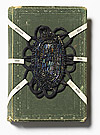Julie GOUGH

My art and research often involve uncovering and re-presenting historical stories as part of an ongoing project that questions and re-evaluates the impact of the past on our present lives. My work is concerned with developing a visual language to express and engage with conflicting and subsumed histories. A key intention is to invite a viewer to a closer understanding of our continuing roles in, and proximity to unresolved national stories—narratives of memory, time, absence, location and representation.
I utilise found and constructed objects and techniques from diverse sources, including the visual arts, museums, libraries, shops, gardens and my ancestry. Much of my influence and inspiration comes from the people, stories, places and skills of and connections to my maternal Tasmanian Aboriginal heritage. I create work by reusing natural materials and found, sometimes kitsch, objects. I particularly enjoy responding to and reconfiguring natural materials, including wood, stone, kelp, bark and shell, into narratives that relate their original environment and my own and my ancestors’ encounters, actions and traces in these places with these same types of materials.
One of my common methodologies is to arrange multiple objects to activate a surface or space optically. The encounter or reading of a work is a means of temporarily holding the objects in place and for viewers to find themselves part of the piece. Works of art comprising multiple objects are experiments in understanding how viewers can travel around a work and, in this process, move their position back and forth, flickering between past and present and hopefully between personal and national memory.
There is nothing cleverer than Julie Gough’s mind at work. A practising artist for just over 20 years, Gough creates sculpture and installation works drawn from personal and shared histories. Her works possess a multiplicity of meanings and intentions; however, none are greater than her intent to uncover and re-present hidden and forgotten histories. For Gough, her ‘work is concerned with developing a visual language to express and engage with’ what she describes as ‘conflicting and subsumed histories’.1[1]
Archival and found objects, including books, antlers, chairs, coal, tea tree and vintage fashion accessories such as ornamental beads, are among the materials brought together to build the central narrative of any given work. Gough often chooses these objects for their provenance, content and symbolism. The stories associated with the objects more often than not enhance the conceptual qualities of Gough’s work, already laden with meaning.
The tactility of Gough’s installation work is a point of interest. Born from the unusual pairing of media, the tactility is both inviting and intriguing. Yet, especially compelling is the way the objects are reframed and their connotations extended beyond their original and individual meanings. However, Gough finds ways to retain elements of an object’s original meaning within its new and extended conceptual framework.
Gough’s works engage with historical narratives and events that have taken place since the coming of the British to Van Diemen’s Land, renamed Tasmania in 1856. Tasmania is an Australian island and state that was settled by the British, first as a penal colony in 1803, then as a colony in 1824. Tasmanian Aboriginal people were, of course, already present.
Like a private detective, Gough trawls the archives as well as oral records uncovering accounts that shed light on the colonial relationship between British settlers and Tasmanian Aboriginal people (and subsequently between Anglo-Australians and Indigenous Australians). A part of this research involves looking into her own genealogy to understand the present and how the legacies of the past invariably shape her identity as a Tasmanian Aboriginal woman with a strong affinity to her Scottish heritage. Gough’s voyages into history provide her with a way to de-fragment her past, to create a clear and linear link, generation by generation, to her maternal ancestors. She was sold for one guinea 2007 and Some Tasmanian Aboriginal children living with non-Aboriginal people before 1840 2008 directly reference Gough’s matrilineal history. However, these works are also representative of the lived experience of many Indigenous Australians and are therefore shared. For many Aboriginal and Torres Strait Islander people, the past is an unknown place due to active government policies that enforced cultural genocide and disconnect between Country and kin.
The artist also creates work about the settlement of Australia to engage wider non-Indigenous audiences. She brings our shared histories to the fore for reconsideration or, for some, to be engaged with for the very first time. Here, Gough provides viewers with an opportunity to consider the tropes of and the bias embedded in Australian history. She guides us to examine what has been recorded and by whom, as well as what has been left out. Gough’s work ‘investigates … the place of memory, forgetting, loss, denial and the potency of the past …’.[2] Fugitive history: Spear/Oar, Head Count, Killymoon 2009, for example, speaks of the shared and uneasy relationship between Tasmania’s Aboriginal and convict pasts—pasts that are integrated in the lives of many Tasmanian Aboriginal people, but now compete as the founding narrative of Tasmania.
What is particularly potent about Gough’s body of work is that it presents the different ways in which Tasmanian Aboriginal people were disconnected from their traditional lands and families. There is something astonishing and confronting, almost disheartening, about such a recounting of dispersal, prohibition, removal and sale of Aboriginal people and of a land-grant system that privileged settlers above and beyond the First peoples of Tasmania.
But, above all, Gough seeks to ‘involve nation, viewer and self in acknowledging our entangled histories’.[3]
Carly Lane
[1] Julie Gough, artist statement, see p 5.
[2] Gough, Julie Gough, 2009, viewed 24 May 2010, tasmania.solidwebhost.com.
[3] Gough, tasmania.solidwebhost.com.



